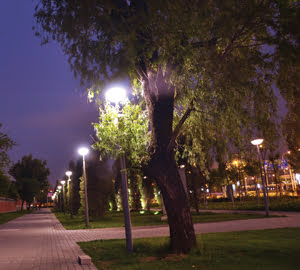Researchers at the University of Pittsburgh
have conducted the first cradle-to-grave assessment of LED streetlights. The report
revealed that, compared with other options, the increasingly popular lamps strike
the best balance between brightness, affordability, and energy and environmental
conservation when life span from production to disposal is considered.
A team of engineers at the Mascaro Center for Sustainable Innovation,
based at Pitt’s Swanson School of Engineering, reported that, while LEDs may
carry a heftier price tag than the country’s two most common lamps –
the high-pressure sodium (HPS) lamps found in most cities and the metal halide lamps
akin to those in stadiums – they consume half the electricity, last up to
five times longer and produce more light. Gas-based induction bulbs, another emerging
technology deemed bright and energy-efficient, proved only slightly more affordable
and energy-efficient than LEDs. However, they may have a greater environmental impact
when in use.
The City of Pittsburgh commissioned the report as it was debating
whether to replace its 40,000 streetlights with LEDs. Several other US cities had
taken the initiative to replace energy-zapping HPS lamps with LEDs, and pilot programs
and retrofits are under way in cities including Los Angeles, San Francisco, Raleigh,
N.C., and Ann Arbor, Mich. The City of Pittsburgh estimated that, per year, the
cost to replace HPS lamps with LED streetlights would save the city $1 million in
energy costs and $700,000 in maintenance. Additionally, carbon dioxide emissions
would be reduced by 6818 metric tons.

Researchers at the University of Pittsburgh report that LED lamps outshine other lighting technologies
in terms of balance of brightness, energy efficiency, life span, cost and low environmental
impact.
Melissa Bilec, a professor and a co-author of the study, said
that, despite the nationwide embracing of LEDs, no comprehensive analysis of LED
streetlights had been done earlier. With the help of professor Joe Marriott, two
students from Pitt and one from the Georgia Institute of Technology, the group created
a “life cycle assessment” for each of the four lighting technologies.
The assessments for each technology, made with information drawn
from sales companies, manufacturers, government documents, lighting professionals
and industry reports, catalogued the environmental effect of the streetlamps during
their complete life span, from extraction of raw materials and assembly, to electricity
consumption and disposal.
According to the report, LEDs have the most negative environmental
and health impact during manufacturing. Because the LED “bulbs” consist
of small lights embedded in circuit boards that require a vast number of raw materials,
they require considerable energy to produce and can be difficult to recycle. Producing
LED housing, however, consumes less energy than manufacturing aluminum-heavy HPS
casings, the team learned, because LED housing is composed mostly of plastic and
wire. Additionally, the bulbs contain no mercury and fewer toxins than HPS and metal
halide bulbs, both of which pack an average of 15 mg of mercury, while induction
bulbs average roughly 6 mg.
The most noteworthy aspect of the report proved to be that electricity
consumption has up to 100 times the environmental impact of manufacturing. The study
found that LED lights burn at approximately 105 W, while HPS lamps burn at 150 W,
and metal halide lights clock in at 163 W.
When electricity consumption is converted into kilograms of carbon
dioxide produced, metal halide bulbs are shown to produce nearly 500 million over
the course of 100,000 hours, whereas HPS bulbs produce more than 400 million, induction
bulbs approximately 350 million and LEDs, slightly more than 300 million. Additionally,
in comparison to metal halide and HPS lights, LED technology reduces by one-third
the airborne toxins and particulates from coal-fired plants.
Outputs of chlorofluorocarbon, a chemical compound contributing
to the ozone layer’s depletion, and nitrogen oxides, the noxious by-products
of burning fossil fuels that can return to Earth in rain and snow as harmful nitrate,
were also studied. The researchers found that, in both categories, LEDs ranked highest
of the four technologies during the bulb manufacturing stage but had the lowest
ranking during actual use. Metal halides produced the greatest emissions of both
pollutants in the final phase.
When it comes down to pennies per lumen, the team found that the
prices of LED lights were highly inconsistent, ranging from $9.20 to $322 per fixture.
However, the technology’s longer life span could offset the price. Initially,
Pittsburgh could purchase 40,000 LED lamps for $21 million versus approximately
$9 million for metal halide streetlights. In the long run, however, replacing metal
halides could cost as much as $44 million before the LED lamps need a first replacement.
While LED lights shine the brightest for their energy efficiency,
balance of brightness, life span, cost and low environmental impact, the researchers
encourage municipalities considering making the switch to seek out vendors wisely.
Because the technology is new and still under development, they recommend choosing
a company based on its age, past performance and on whether the technology has been
vetted by independent laboratories.